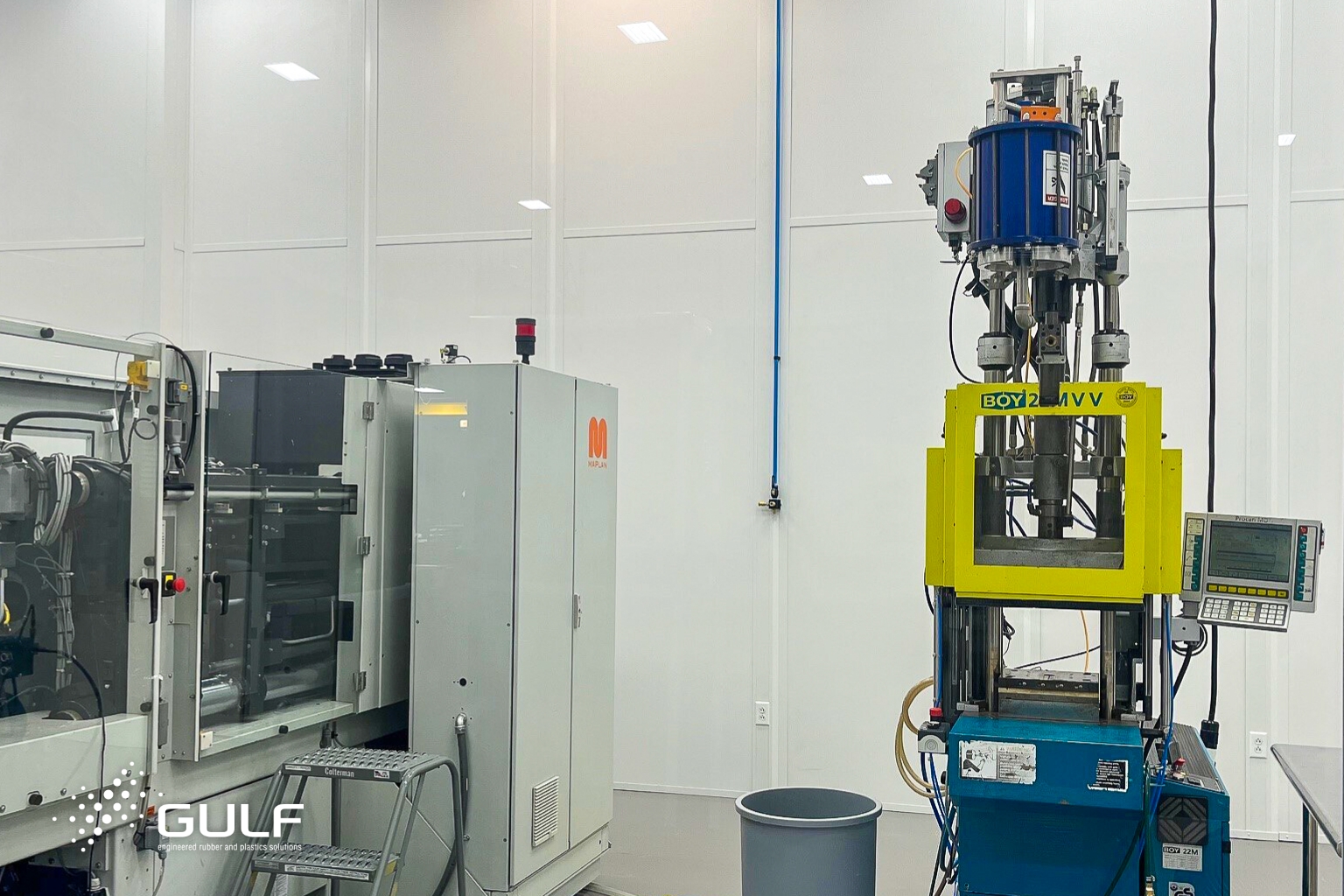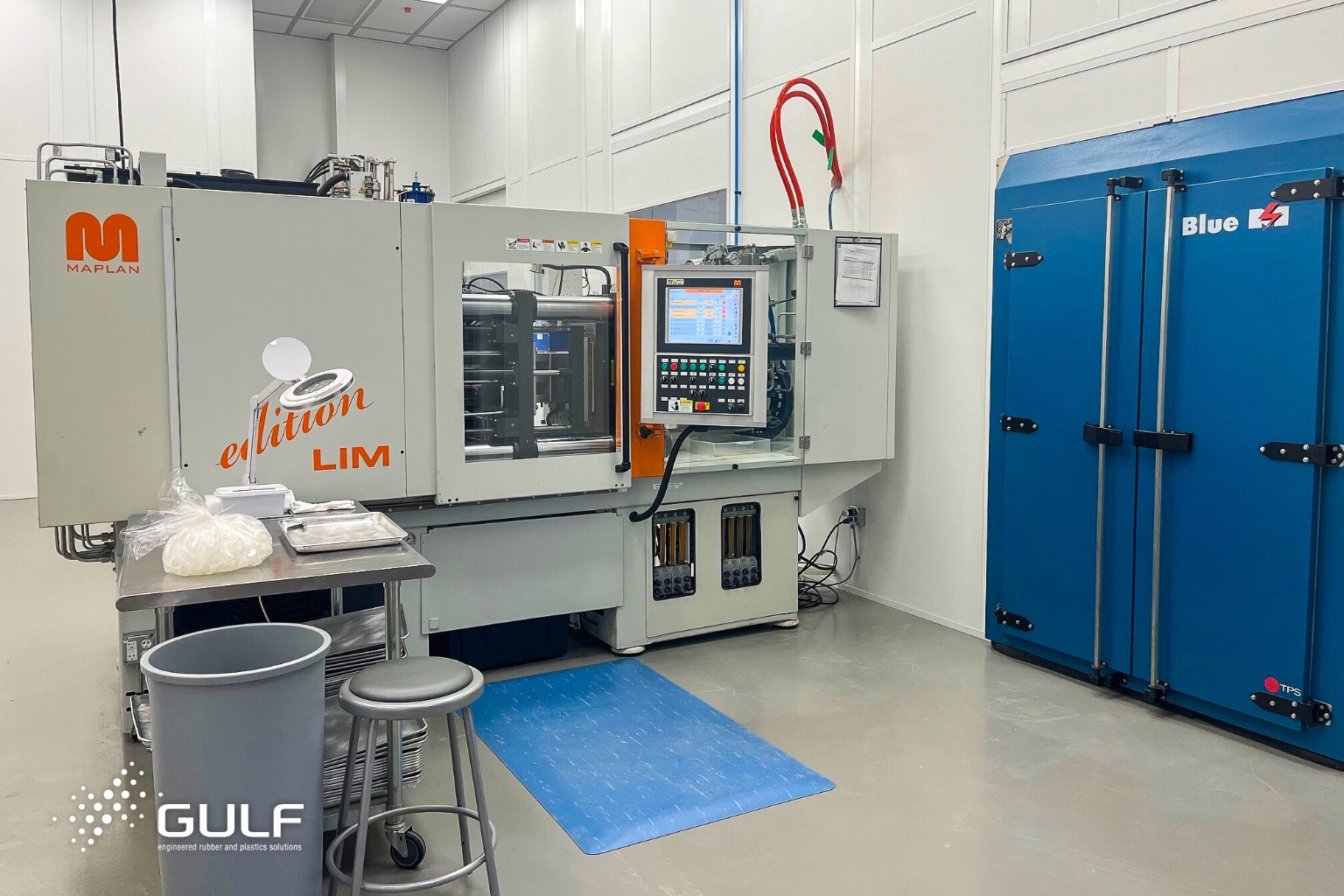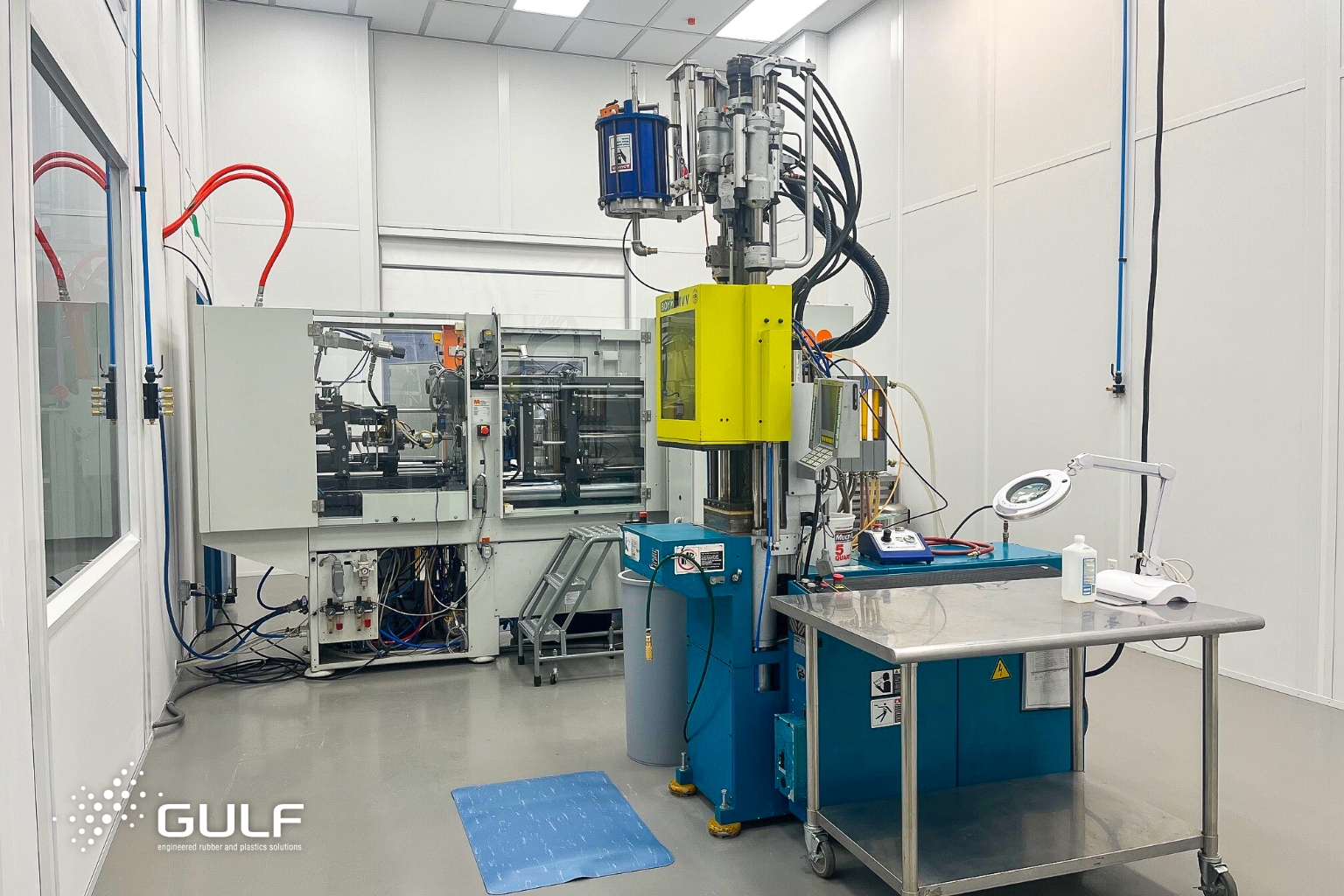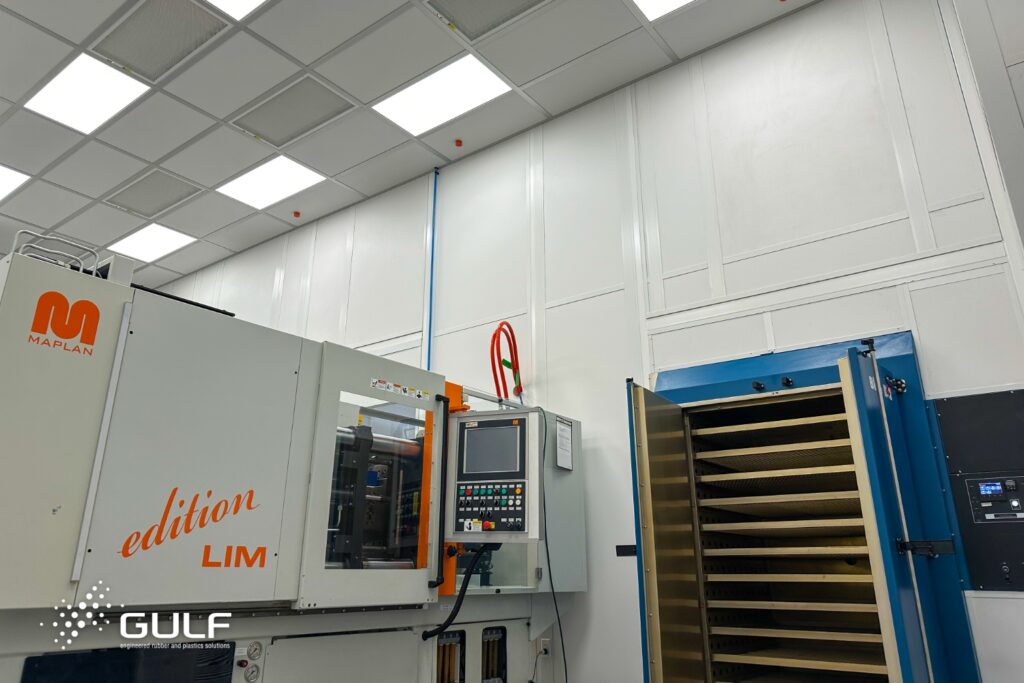
Gulf U.S. Engineered Rubber and Plastic Solutions Opens Medical Grade Cleanroom
Gulf U.S. Engineered Rubber and Plastic Solutions Opens Medical Grade Cleanroom: Cutting-Edge Medical Device Component and Assembly Manufacturing Begins
Gulf U.S. Engineered Rubber and Plastic Solutions, medical device component manufacturer, has completed construction on a new ISO Class 7 (Fed-Std 209E Class 10,000) certified cleanroom in their ISO-13485 certified facility in Whitewater, Wisconsin, and operations have commenced building Liquid Silicone Rubber (LSR) components and assemblies for medical devices. The new ISO Class 7 cleanroom also houses research and development (R&D) activities utilizing state-of-the-art equipment and represents a significant milestone for Gulf, thus demonstrating the commitment to innovation and manufacturing the highest quality, precision engineered medical device components and assemblies in the industry.

In this blog, we’ll explore medical grade cleanrooms. What are they? What environmental controls and safety measures are in place to uphold strict regulations and standards to manufacture medical device components and assemblies? We’ll also touch on the future of medical grade cleanrooms and the new ISO-13485 certification at Gulf. Let’s peek into the inner workings and exciting innovations of medical grade cleanrooms.
What is a Medical Grade Clean Room for Medical Device Components and Assemblies?
A medical grade cleanroom is a controlled and sterile environment where medical device components and assemblies are manufactured under strict regulation. These spaces are designed and built to keep air pollutants like dust, airborne microbes, and aerosol particles out of the production processes and the room as well as maintaining temperature and humidity in order to facilitate more stable manufacturing processes.
When air pollutants are present, risk of infection and introduction of foreign material increases, which may result in serious health and safety issues. In a healthcare setting, hygiene and preventing contamination are key to the safety of patients and providers, which is why Gulf has built our medical grade cleanroom, so the manufacturing of your medical device components and assemblies are controlled under strict, regulated industry standards.
Air Controls in a Medical Grade Room
In the Gulf medical grade cleanroom, technology and precision air control systems work to eliminate pollutants, particles, and contaminants from the air. Here are some of the innovative air control systems used in our state-of-the-art facility for manufacturing the highest-quality medical device components and assemblies in the industry.
Air Filtration: Dust and microbes are filtered through the fine mesh of high-efficiency particulate air (HEPA) filters or ultra-low penetration air (ULPA). HEPA filters have impressive effectiveness, reaching a 99.97% removal rate for particulate matter with a diameter of 0.3 microns or larger. ULPA filters boast an exceptional 99.999% efficiency in eliminating submicron particulate matter, specifically targeting particles as small as 0.12 microns or larger.
Airflow Control: Precise airflow patterns are designed in the development of a medical grade cleanroom. This can be done by managing pressure inside the cleanroom compared to surrounding areas. The goal is for these patterns to minimize contamination and get air flowing in a desired direction efficiently out of the room by maintaining positive pressure. A common airflow pattern used in medical device cleanrooms is a laminar flow. In a laminar flow, air moves in one direction with minimal turbulence, typically from ceiling to floor in a vertical fashion. This pattern has tight control of the air movement in the room, ensuring the least amount of mixing of air as possible.
Temperature and Humidity Control: There are strict standards for temperature and humidity control within cleanrooms. Setting these standards and controls for a cleanroom prevents moisture from accumulating in the room and harboring contaminants. For example, the low humidity environment in a medical device cleanroom may cause static build up resulting in contamination or damages inside the room. Controlling the temperature and humidity level in the clean room has the added benefit of making production processes more stable and repeatable. When parts are manufactured in a consistent environment, settings don’t have to change based on the season or the weather outside, thus resulting in better and more consistent part quality.

Safety Measures for Medical Device Manufacturer
Air control is just one way to uphold the standards of cleanliness of a medical grade cleanroom. Additional tactics to meet safety measures are personnel procedures, equipment sterilization, regular monitoring, entry and exit protocol, and restricting certain materials from entering the cleanroom (e.g. cardboard). Adding these safety protocols to air control creates a comprehensive approach to maintaining a sterile environment.
Personal Protective Equipment: Strict gown procedures must be followed before entering a medical grade cleanroom. Wearing items such as coveralls, frocks, face masks, hoods, gloves, hair covers, and shoe covers prevent the shedding of particles like hair and dandruff as much as possible within the room.
Equipment Sterilization: All mechanisms and tools used to manufacture medical device components are sterilized thoroughly before they’re able to enter the cleanroom. This ensures they don’t introduce contaminants from the ambient air into the room. Finished medical devices also have a final sterilization process before being packaged.
Monitoring: One of the most important contributors to meeting required cleanroom standards for medical device components is regular system monitoring. This ongoing surveillance ensures that the cleanroom maintains optimal conditions by tracking particle counts, temperature, humidity, and other critical parameters. Consistent monitoring plays a pivotal role in upholding stringent quality standards when manufacturing medical device components.
Entry and Exit Protocols: Strict entry and exit protocols for all people entering and exiting the cleanroom will limit the number of microbial contamination brought in by opening and closing the entryway to the cleanroom. In addition, it’s common to limit the number of people at the facility authorized to access the cleanroom and enforce a strict visitor policy.
Future Trends in Medical Device Cleanrooms
Trending topics for the future of medical grade cleanrooms include automation and robotics for preventative maintenance and optimization of operations. Energy efficiency is always top of mind in the industry, as well as advanced filtration systems and nanotechnology integration, considering its relevance to medical device components being manufactured smaller and smaller. Enhanced materials are on the horizon for creating more durable and easier to clean surfaces, and new safety features are constantly being discussed including ergonomic cleaning and personal protective equipment.
Gulf remains the nation’s leading medical device manufacturer in technology and innovation, constantly looking forward to what’s ahead as manufacturing of medical device components and assemblies begins in the ISO Class 7 medical grade cleanroom in Wisconsin. The investment in research and development (R&D) is ongoing, and partnerships with leading technology providers are thriving, all with a proactive approach to exploring emerging trends. This forward-thinking strategy positions Gulf to not only meet current industry standards but also to anticipate and address future challenges.
Contact Medical Device Component Manufacturer for Your Next Medical Device Component Project
General manufacturing facilities are not held to the same standards as cleanrooms. This is why last year, Gulf received its ISO 13485:2016 Quality Management System certificate from INTERCERT for Medical Devices. Gulf’s medical grade cleanroom not only met the requirements of ISO Class 8 (Fed-Std 209E Class 100,000) but also ISO Class 7 (Fed-Std 209E Class 10,000). These certifications mean that Gulf meets the requirements for the manufacture, sales, and distribution of liquid silicone rubber (LSR) injection molded products for medical device components and assemblies.
When considering your next medical device component or assembly project, it is essential to research the facility where it was manufactured and the quality management system certification they achieve to ensure continuation of ongoing cleanliness protocols and standards. Gulf understands that maintaining an ultra-clean production environment facilitating stable processes is critical to you and the success of your business. Contact our expert team of engineers today to discuss your project.

